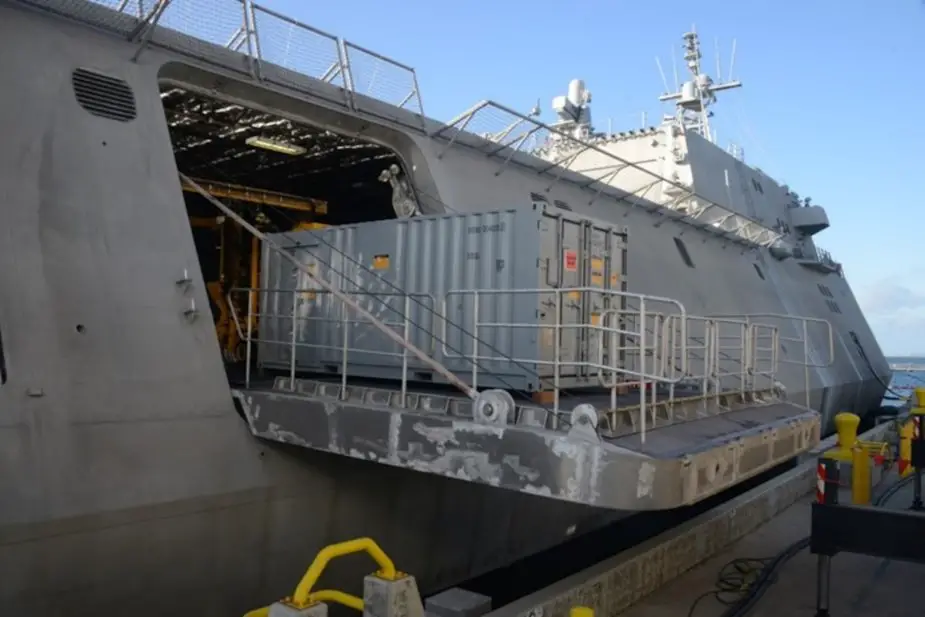According to information published by the US DoD on May 3, 2023, the Navy’s Littoral Combat Ship (LCS) mine countermeasures mission package (MCM MP) and AN/AQS-20 Sonar Mine Detection Sets achieved initial operational capability (IOC).
Follow Navy Recognition on Google News at this link
 The Mine Countermeasures Mission Package (MCM MP) is loaded onto the USS Cincinnati (LCS 20) ahead of End-to-End Testing before Initial Operational Test and Evaluation. (Picture source: US DoD)
The Mine Countermeasures Mission Package (MCM MP) is loaded onto the USS Cincinnati (LCS 20) ahead of End-to-End Testing before Initial Operational Test and Evaluation. (Picture source: US DoD)
The MCM MP is an integrated suite of unmanned maritime systems and sensors that counteracts mines in the littorals while increasing the host vessel's standoff distance from the threat area.
An LCS or a vessel of opportunity, when embarked with the MCM MP, can conduct the full spectrum of detect-to-engage operations (hunt, neutralize, and sweep) against mine threats using sensors and weapons deployed from the MCM Unmanned Surface Vehicle (USV), an MH-60S multi-mission helicopter, and associated support equipment.
The AN/AQS-20 is a mine hunting and identification system that houses sensors in an underwater towed body, which integrates the Wideband Forward-Looking Sonar (WBFLS), two multi-function Side Look Synthetic Aperture Sonars (MFSLS), and Digital Gap Fill Sonar (DGFS) for the detection, classification, and localization of targets.
The integration of the Electro-Optic Identification (EOID) sensor provides additional capability. Similar to the Unmanned Influence Sweep System (UISS), which achieved IOC in July 2022, the AN/AQS-20 is towed from the MCM USV.
The MCM MP IOC declaration follows rigorous initial operational testing and evaluation (IOT&E) of the full mission package, including the AN/AQS-20 system, during the fall of 2022 aboard USS Cincinnati (LCS 20).
The package allows the Navy to enhance its mine countermeasures capabilities in the littoral environment, which is critical for ensuring the safety and security of naval vessels and their crews.
About the USS Cincinnati
The Independence-class littoral combat ship has a displacement of 2,307 metric tons (light), 3,104 metric tons (full), and 797 metric tons (deadweight). The vessel measures 127.4 meters (418 feet) in length and 31.6 meters (104 feet) in beam, with a draft of 14 feet (4.27 meters).
The propulsion system consists of two gas turbines, two diesel engines, four waterjets, a retractable Azimuth thruster, and four diesel generators. The vessel has a top speed of 40 knots (74 km/h; 46 mph) and can sprint at 47 knots (54 mph; 87 km/h). Her range is 4,300 nautical miles (8,000 km; 4,900 mi) at 20 knots (37 km/h; 23 mph).
The Independence-class littoral combat ship has a capacity of 210 metric tons and a complement of 40 core crew (8 officers and 32 enlisted) with the capacity to carry up to 35 mission crew.
She is equipped with a Sea Giraffe 3D Surface/Air RADAR, Bridgemaster-E Navigational RADAR, and AN/KAX-2 EO/IR sensor for GFC. Electronic warfare and decoy systems include an EDO ES-3601 ESM and four SRBOC rapid bloom chaff launchers.
The vessel is armed with a BAE Systems Mk 110 57 mm gun, four .50 cal (12.7 mm) guns (two aft and two forward), and an Evolved SeaRAM 11 cell missile launcher.
The Independence-class also has the capability to deploy mission modules, including anti-submarine warfare, mine countermeasures, and surface warfare modules. The vessel can carry two MH-60R/S Seahawks and an MQ-8 Fire Scout aircraft.



